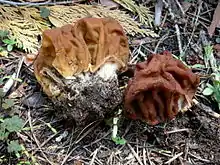Gyromitra gigas
Gyromitra gigas, commonly known as the giants false morel,[5][6][7] snow morel, snow false morel, calf brain, or bull nose, is a fungus and a member of the Ascomycota. G. gigas is found in Europe. It is referred to as one of the false morels, due to its similar appearance and occurrence in the spring and early summer in similar habitats to true morels (Morchella ssp.). It contains small quantities of hydrazines,[8] its content in gyromitrin was scientifically assess by Viernstein et al. [Botanical identification 1980] and resulted of about 1mg per kg of fresh mushroom (roughly 1500 fold less compared to esculenta). No casualties have been ascribed to its consumption, parboiling is still highly recommended. Some guides have listed it as being edible if properly prepared. However, consumption is not recommended due to variability and similarity to other more toxic species of Gyromitra.[9]
| Snow Morel | |
|---|---|
 | |
| Scientific classification | |
| Domain: | Eukaryota |
| Kingdom: | Fungi |
| Division: | Ascomycota |
| Class: | Pezizomycetes |
| Order: | Pezizales |
| Family: | Discinaceae |
| Genus: | Gyromitra |
| Species: | G. gigas |
| Binomial name | |
| Gyromitra gigas | |
| Synonyms[1] | |
| Gyromitra gigas | |
|---|---|
| Smooth hymenium | |
| Cap is convex | |
| Hymenium attachment is irregular or not applicable | |
| Stipe is bare | |
| Spore print is yellow to buff | |
| Ecology is saprotrophic or mycorrhizal | |
| Edibility is not recommended | |
This fungus has been banned for sale in France since 1991 due to potential toxicity, the effects of which would cause a fairly rare fatal neurodegenerative disease, amyotrophic lateral sclerosis (ALS).[10] [11]
A similar and possibly directly related species, Gyromitra montana, occurs in North America; the main difference between the two is the smaller spores G. gigas is reported to have.[12] G. montana is reportedly a good edible mushroom if cooked thoroughly and eaten in small quantities.[13]
Taxonomy
The species was first described scientifically by Julius Vincenz von Krombholz as Helvella gigas.[2]
See also
- Gyromitrin, a toxic chemical found in Gyromitra fungi
References
- "Gyromitra gigas (Krombh.) Cooke 1878". MycoBank. International Mycological Association. Retrieved 2012-11-04.
- von Krombholz JV. (1834). "Naturgetreue Abbildungen und Beschreibungen der Schwämme" (in German). 3: 1–36.
{{cite journal}}: Cite journal requires|journal=(help) - Imai S. (1938). "Symbolae ad floram mycologicum asiae orientalis II". Botanical Magazine Tokyo. 52 (619): 357–63. doi:10.15281/jplantres1887.52.357.
- Eckblad FE. (1968). "The genera of the operculate discomycetes". Nytt Magasin for Botanik. 15 (1–2): 1–191 (see p. 99).
- "Gyromitra gigas · giants false morel". The British Mycological Society. Archived from the original on 2022-02-05. Retrieved 2021-05-21.
- "Gyromitra gigas · giants false morel". NBN Atlas. Retrieved 2021-05-21.
- "Giant's False Morel (Gyromitra gigas)". Ninaturalist.nz. Retrieved 2021-05-21.
- Phillips, Roger (2010). Mushrooms and Other Fungi of North America. Buffalo, NY: Firefly Books. p. 363. ISBN 978-1-55407-651-2.
- Volk T. (May 2002). "Tom Volk's Fungus of the Month: Gyromitra esculenta". Retrieved 2011-05-03.
- "Un champignon lié à des cas de maladie de Charcot : la fin d'une énigme médicale vieille de plus de dix ans" (in French). 4 September 2021.
- "An amyotrophic lateral sclerosis hot spot in the French Alps associated with genotoxic fungi".
- Miller Jr., Orson K.; Miller, Hope H. (2006). North American Mushrooms: A Field Guide to Edible and Inedible Fungi. Guilford, CN: FalconGuides. p. 509. ISBN 978-0-7627-3109-1.
- Trudell, Steve; Ammirati, Joe (2009). Mushrooms of the Pacific Northwest. Timber Press Field Guides. Portland, OR: Timber Press. p. 281. ISBN 978-0-88192-935-5.